What Is Ecommerce Link Building?
Ecommerce link building is the process of getting other websites to link back to your ecommerce site. The primary goal is to increase your store’s ranking in search engine results pages (SERPs).
Here’s what a link to an ecommerce brand looks like from First We Feast:

Links back to your site are known as “backlinks” (also called inbound links). Each backlink is like a vote of confidence. They suggest to search engines like Google that another site vouches for you.
As a collection, backlinks make up your “backlink profile.” In general, the stronger your backlink profile, the better your search performance.
The result?
- Improved credibility
- More traffic to your store
- Increased sales
Let’s look at seven proven ecommerce link building tactics to earn quality links from trusted sources.
1. Publish High-Quality Blog Content for Specific Keywords
High-quality content—like well-written and useful blog posts—is a proven way to improve SEO rankings and increase conversions.
But that’s not the only use for an ecommerce blog. Blogging is a great way to generate backlinks over time.
Attach a blog to your online store. Then, write articles that target search terms relevant to your product or service.
Let’s say you sell surfboards.
You could write a blog post on “best surfboards for beginners,” and include several boards that you sell.
Just like this post by Lush Palm:

When beginner surfers are looking for their first board on Google, they come across your blog.
They click on one of the product pages for a board you discuss. And you make a sale.
But there’s also the link building benefit:
A company that offers surf lessons may also come across your post. Its team isn’t in the market for beginner boards. But they think it’s a great resource to link to in their “tips for beginner surfers” blog. So, they do.
You just got an ecommerce backlink.
It won’t always happen that easily, of course. Content marketing and organic link building are long-term strategies. It can take three to 12 months to see changes in site visibility.
But consistently creating quality content can yield positive results for your link building strategy.
That’s why you need a steady pipeline of keywords to target with your blog posts. So, how do you find your own relevant keywords to target? Use Semrush’s Keyword Magic Tool.
We’ll stick with our surfboard example.
Enter a broad, basic term related to your ecommerce website. We call this your “seed keyword.”
Then click “Search.”

The tool will show you every keyword related to your seed keyword.
You’ll be provided with about 117K here:
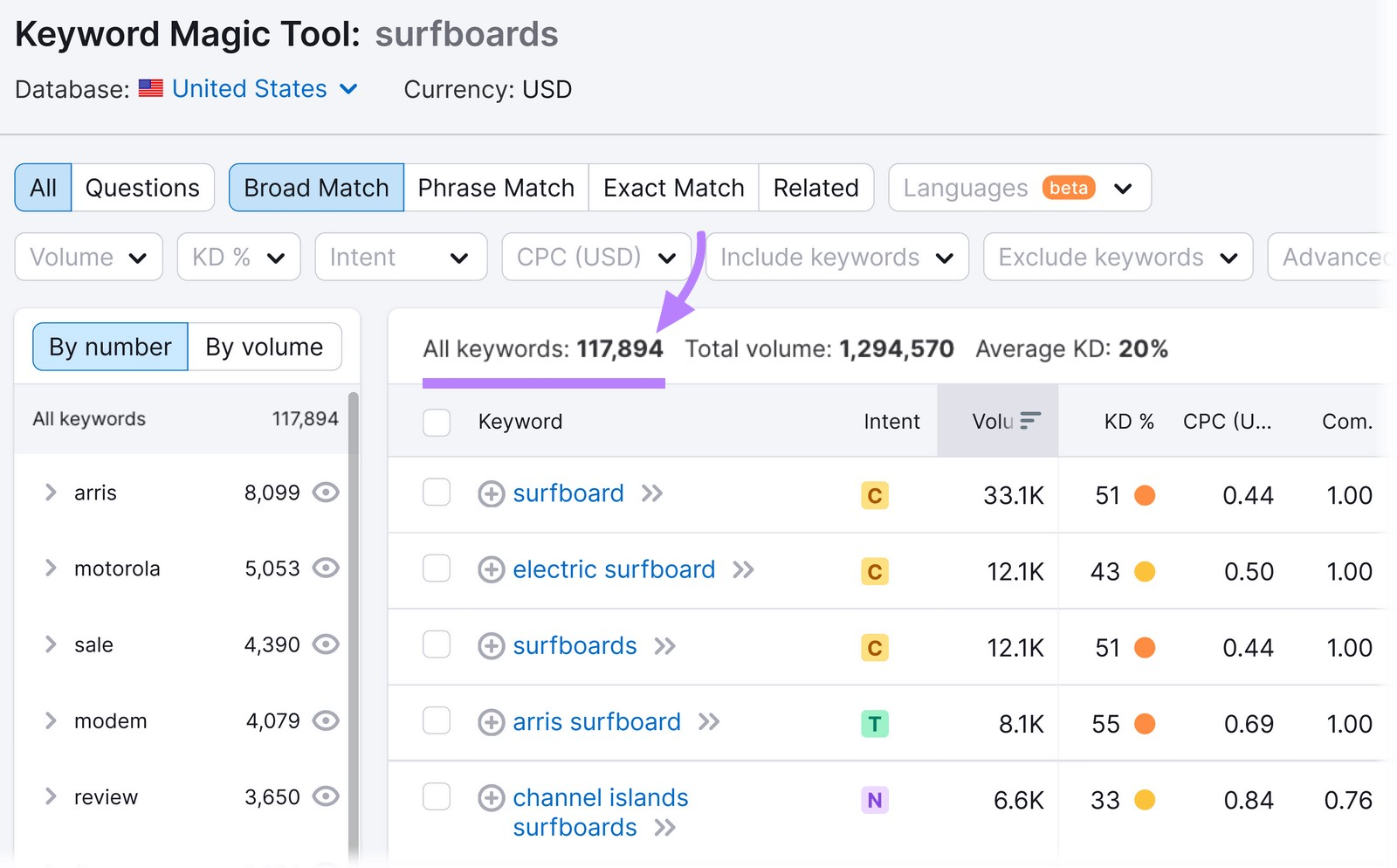
You can use the column on the left to filter results by topic:
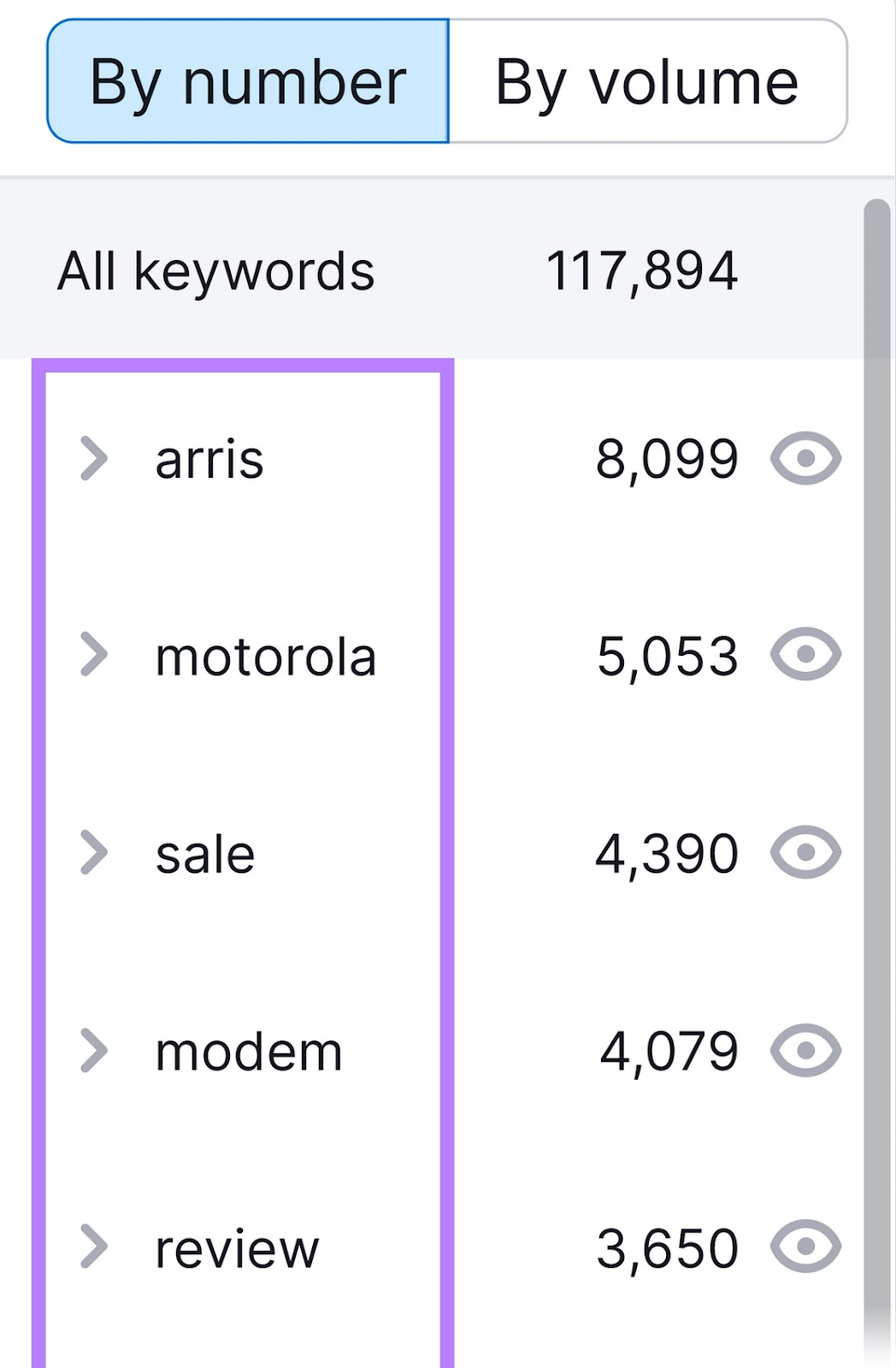
For example, if we click “review,” we get a list of results that include the term “review”:
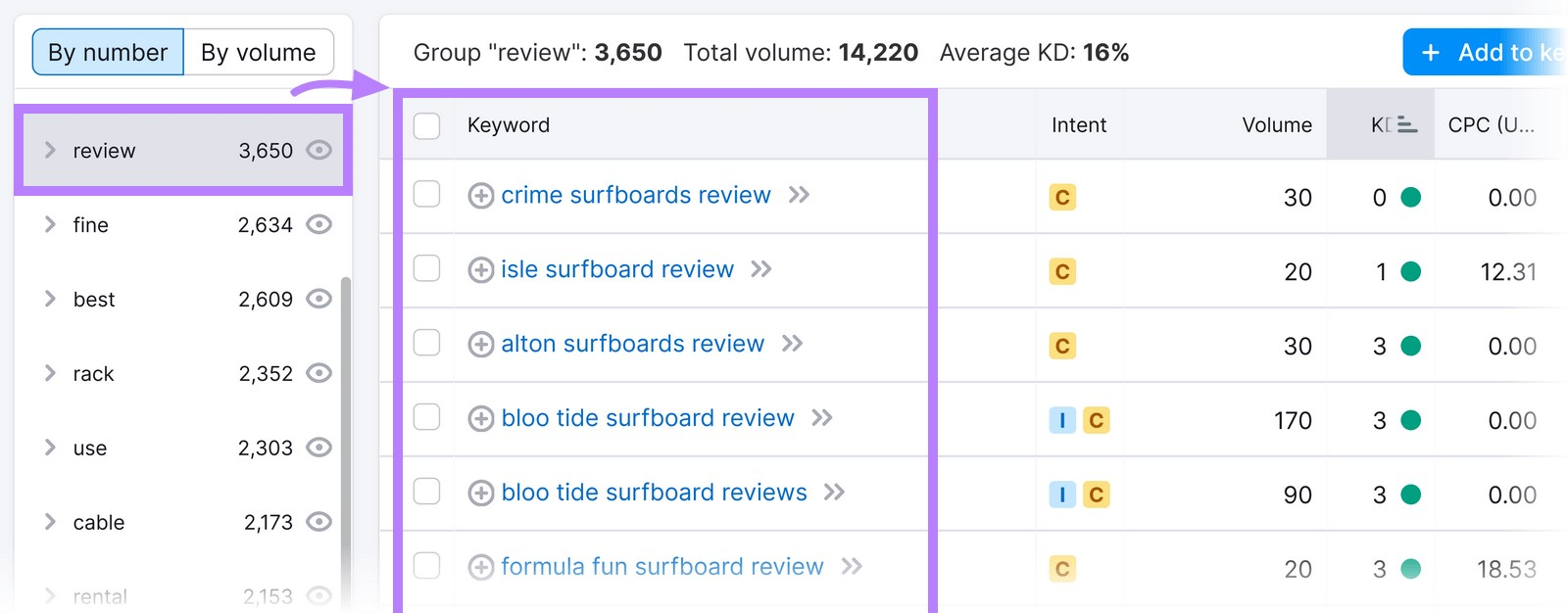
The lower the keyword difficulty (KD), the easier the terms will be to rank for. You can filter these from easiest to most difficult.
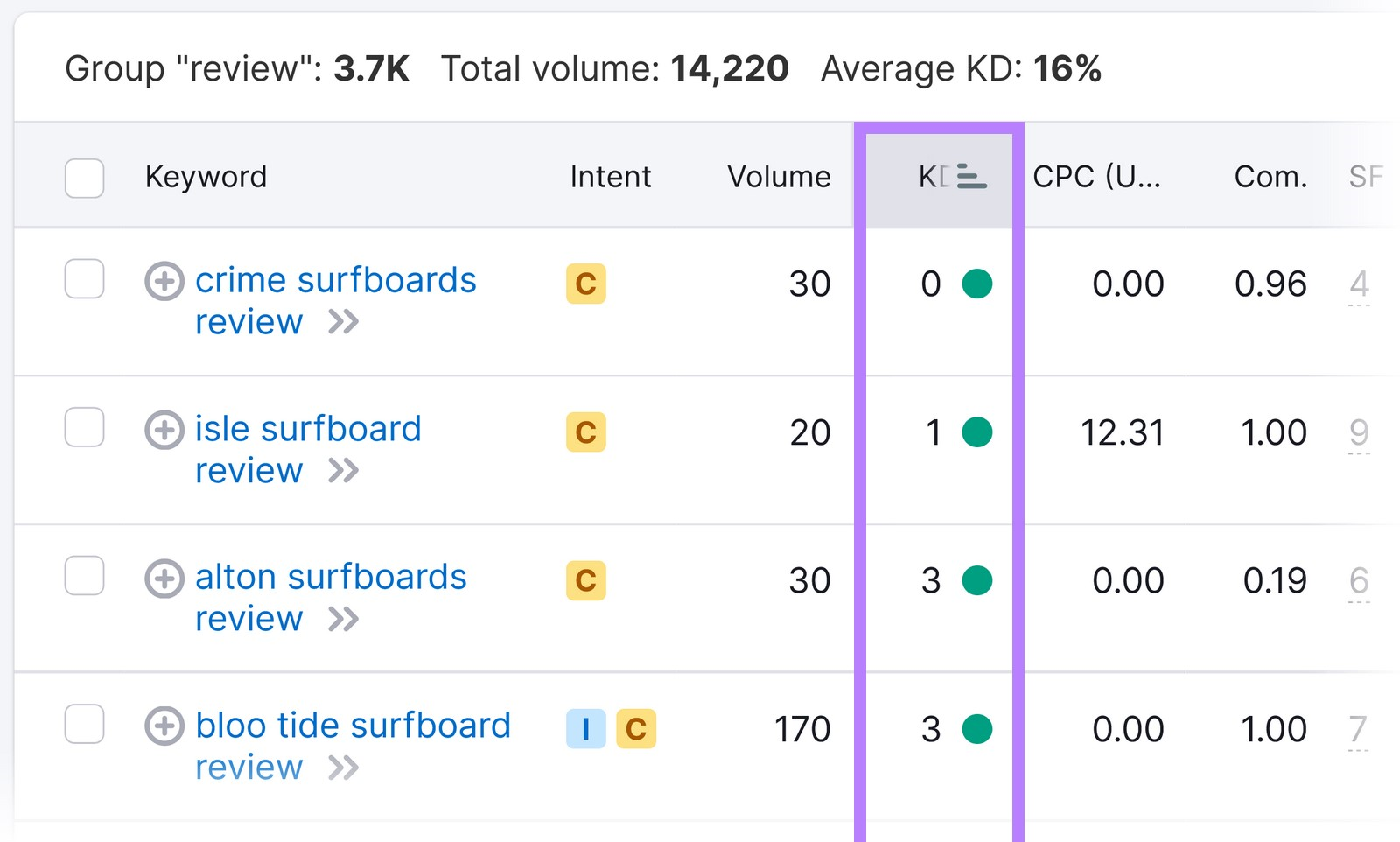
Find keywords that are relevant to your business and target customer, and write blog posts to target them. Over time, this strategy can generate powerful ecommerce backlinks.
Further reading: How to Use Semrush for Keyword Research
2. Try HARO and Become a Source for Bloggers and Reporters
Using HARO is “one of the best ways to build high-quality backlinks at scale,” according to Brian Dean at Backlinko.
HARO stands for “Help a Reporter Out.” Its platform connects journalists and bloggers with experts on issues related to their content.
By creating a HARO account, you can offer your industry knowledge to journalists and bloggers writing about your industry. They may quote you in their articles. And when they do, they’re likely to link back to your ecommerce website.
Here’s how to sign up:
Head to the HARO website. Then, click “I’m a source” for a list of the rules:

Once you’ve read through the terms, click “Sign up.”
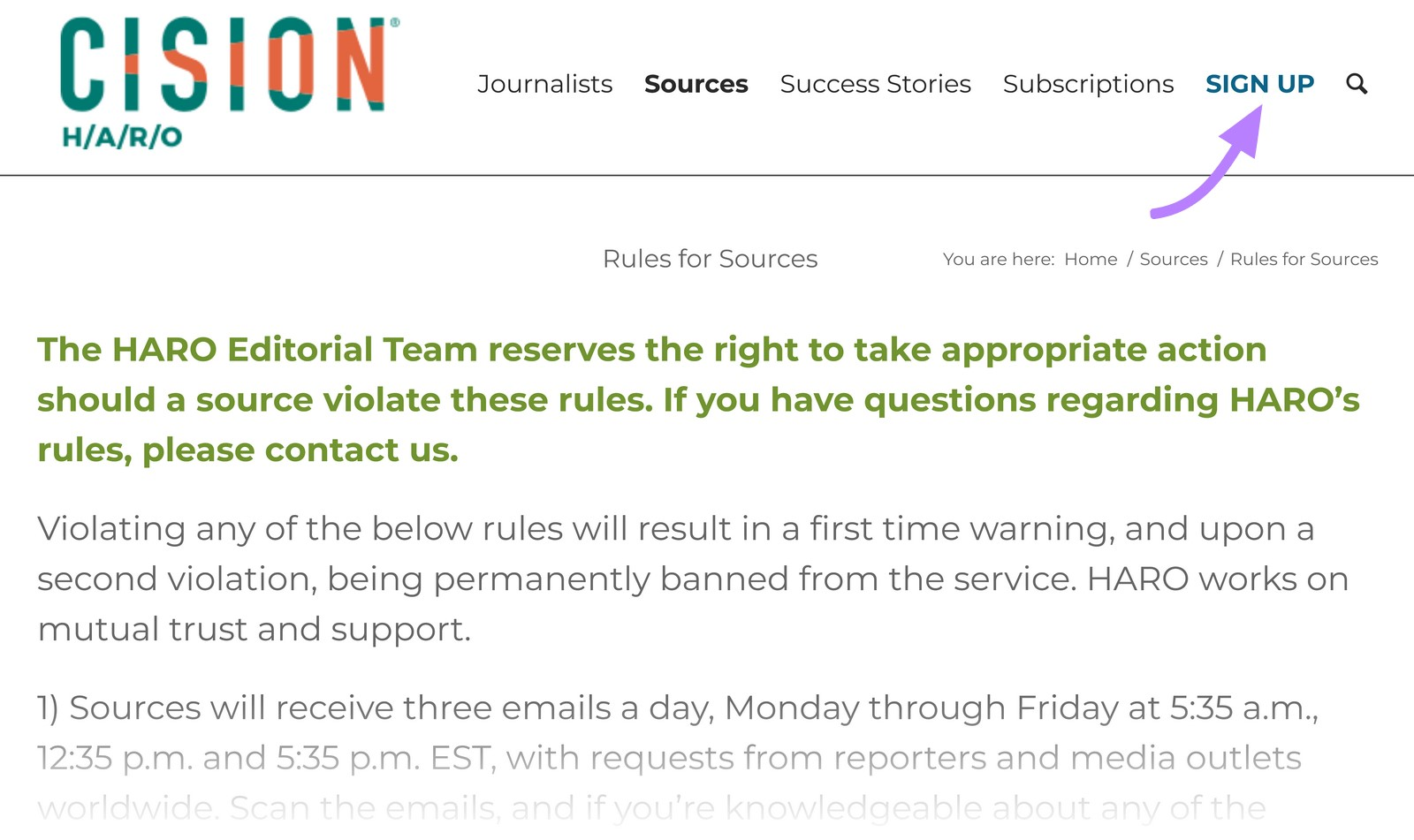
That takes you to the basic subscription signup page. Fill in your information and click “Sign up.”
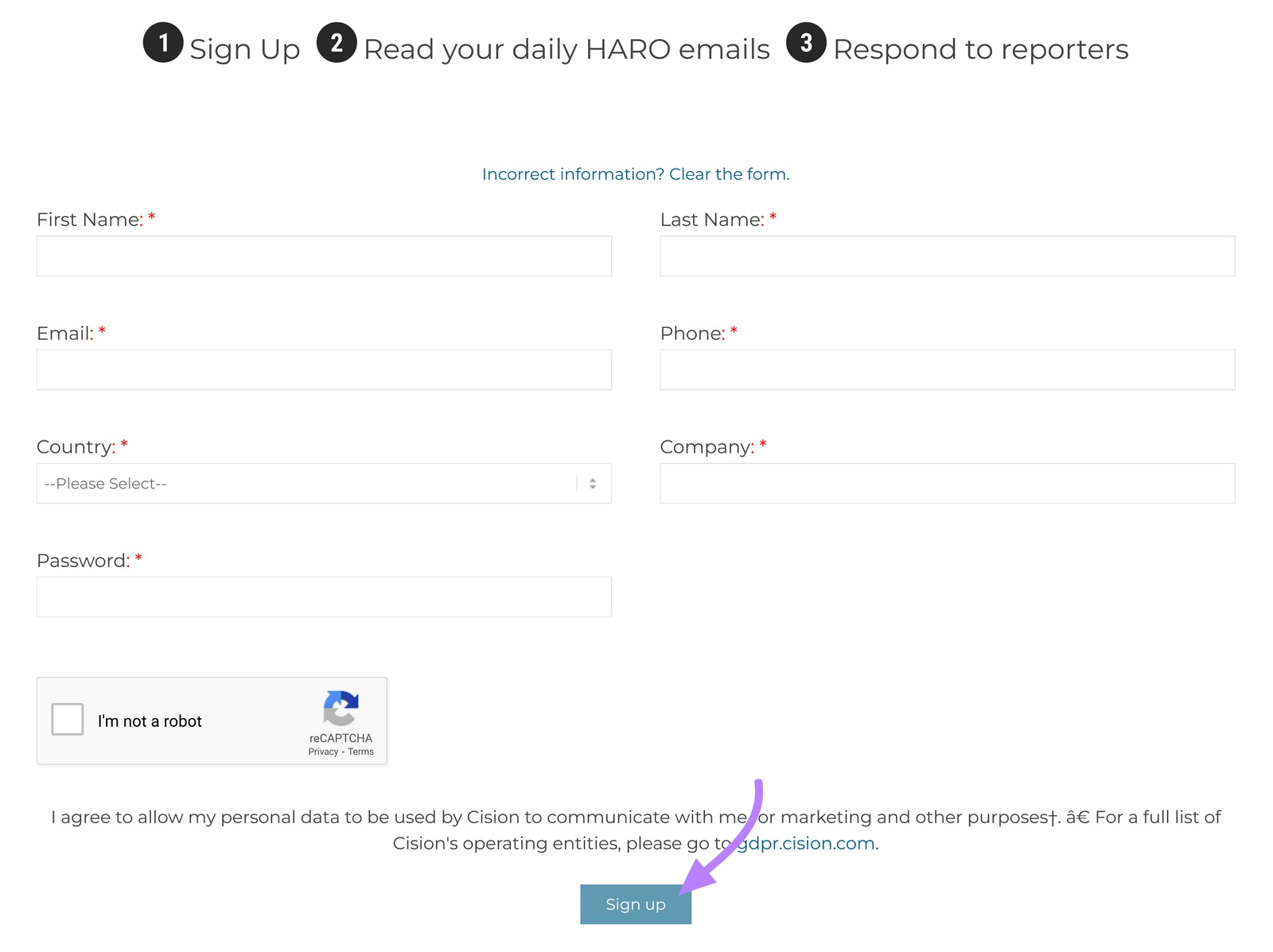
HARO sends you emails with journalists’ and bloggers’ pitch requests three times per day. When you find a pitch request that applies, you can pitch your answer.
Here’s an example of a query from online magazine Best Life:

Keep in mind that requests may go out to many people with expertise that’s similar to yours. So make sure you’re offering valuable information when pitching. Otherwise, the writer will choose another answer.
Not every outreach will be successful. And some successes won’t result in a backlink. But each HARO email is a link building opportunity worth the effort.
3. Organize a Creative Campaign for PR
Product public relations (PR) can create a ton of backlinks, traffic, and sales—if you use it creatively.
Take this creative campaign by Rise at Seven PR. It took fashion brand Missguided to the #1 spot on Google:

The retailer’s jumpers weren’t ranking well. When the PR firm found identical women’s jumpers on the site, they launched the exclusive story with TYLA.
The firm landed 30k engagements on social media within an hour. This success led to a new optimized category page and product line.
The Missguided team also supplemented the campaign with blog content. And they used internal linking to pass more value to the category page.
The result?
Some 60 backlinks (plus thousands of social media links), sold-out stock, and five figures in revenue.
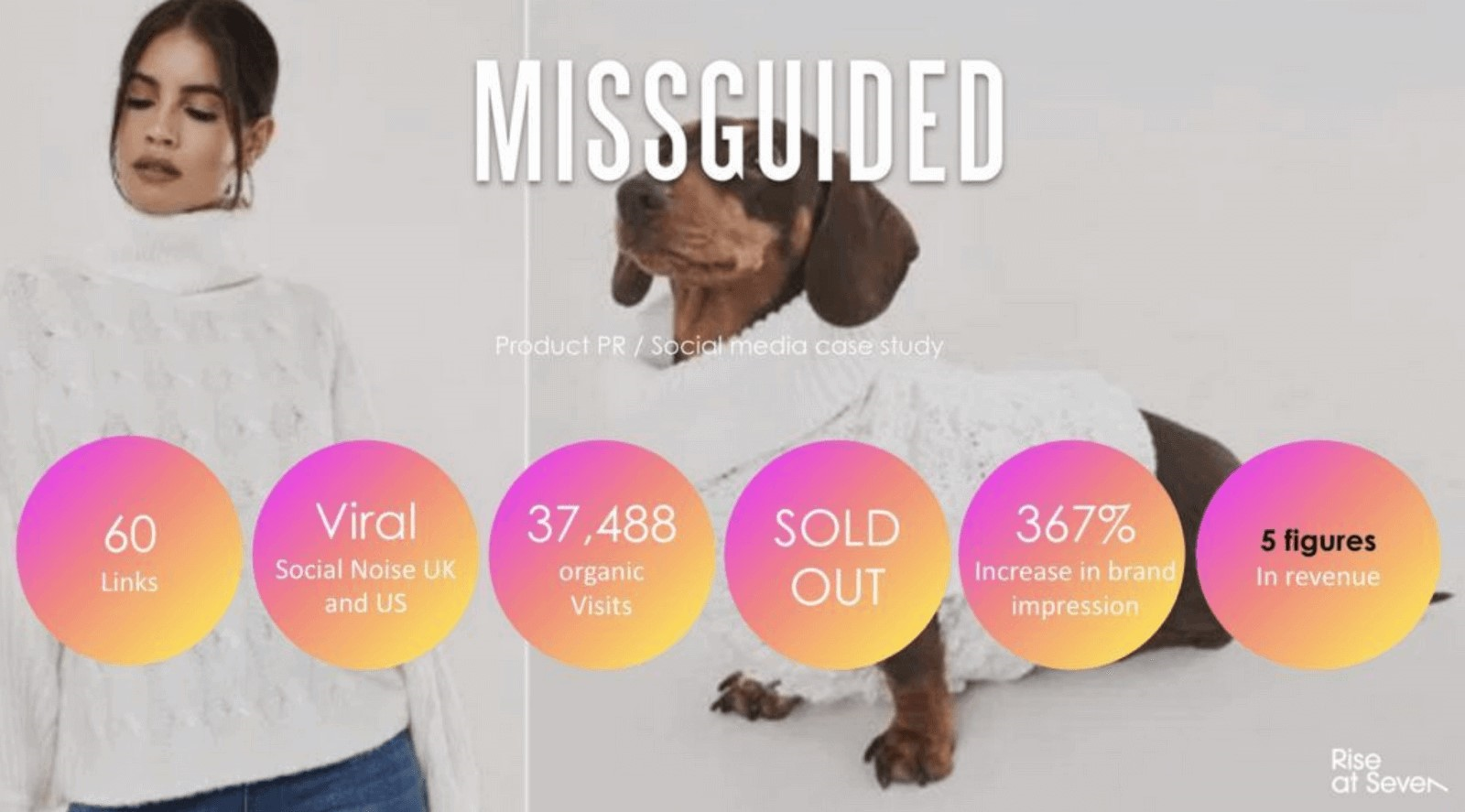
Find inspiration for your own creative PR campaign by analyzing others.
Create a list of your favorites and ask yourself these questions:
- Who is the intended audience?
- Why did the campaign work so well?
- What resources have they used to make it successful?
- Which channels did they market the campaign on?
Figuring out the answers can help you develop a base for your own campaign.
But don’t forget the golden rule: Make sure it’s something newsworthy.
Further reading: A Guide to Digital PR
4. Ask Partners to Link to Your Site
Are you a reseller or retail ecommerce seller?
Contact suppliers and distributors that curate lists of where to purchase their products. And ask them to include yours.
Let’s say you stock Greenies pet food.
This list of vendors is the kind you want your site to be on:
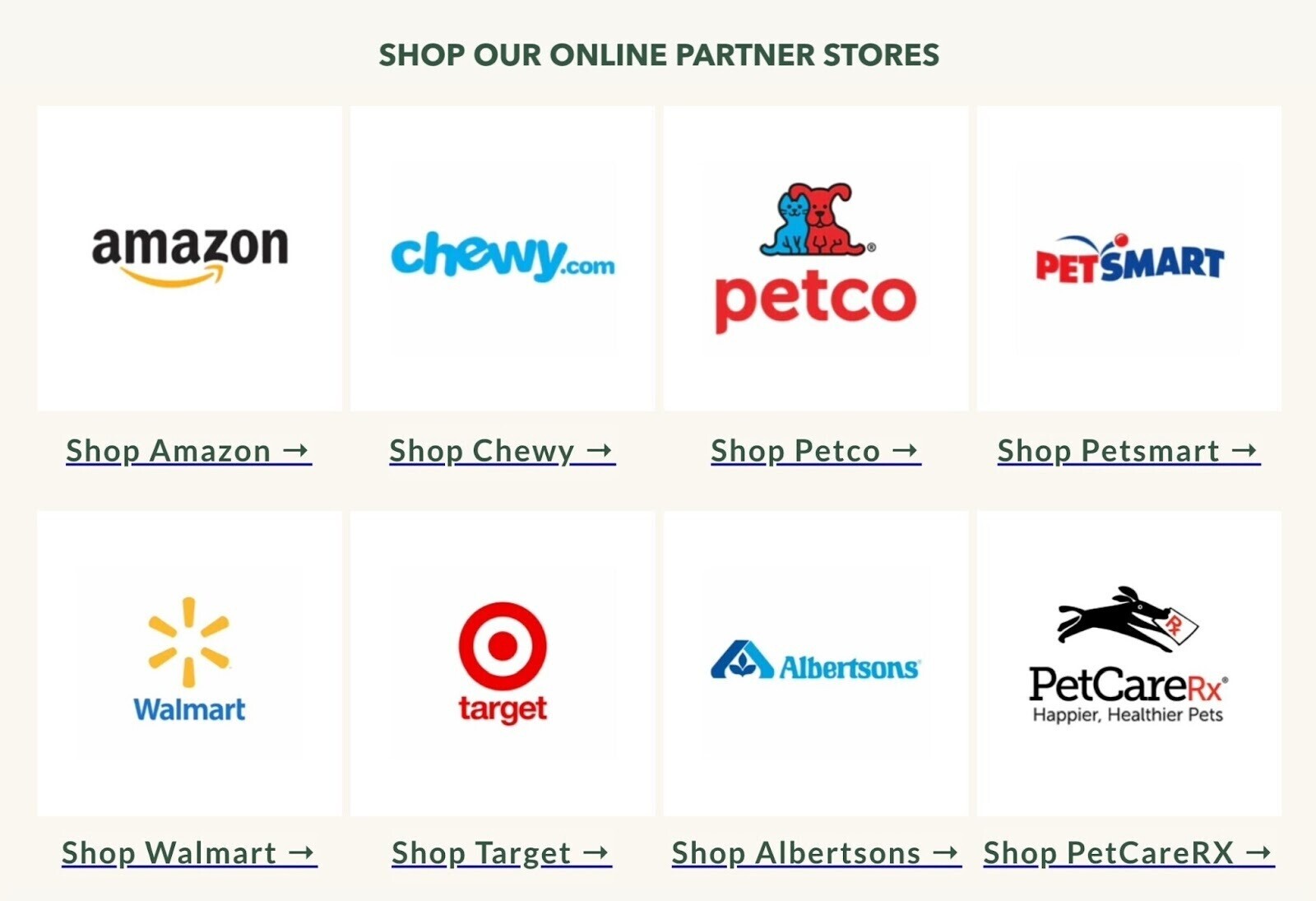
If you have distributors or stockists, you’ve started to build relationships with the vendors. So, the hardest part is already done.
Go through your list of partners and ask them to link to your site.
You can also branch out to online business directories, such as
A quick Google search will reveal tons of industry-specific directories.
If we stick to pet food, we could search “pet food + online directories”:
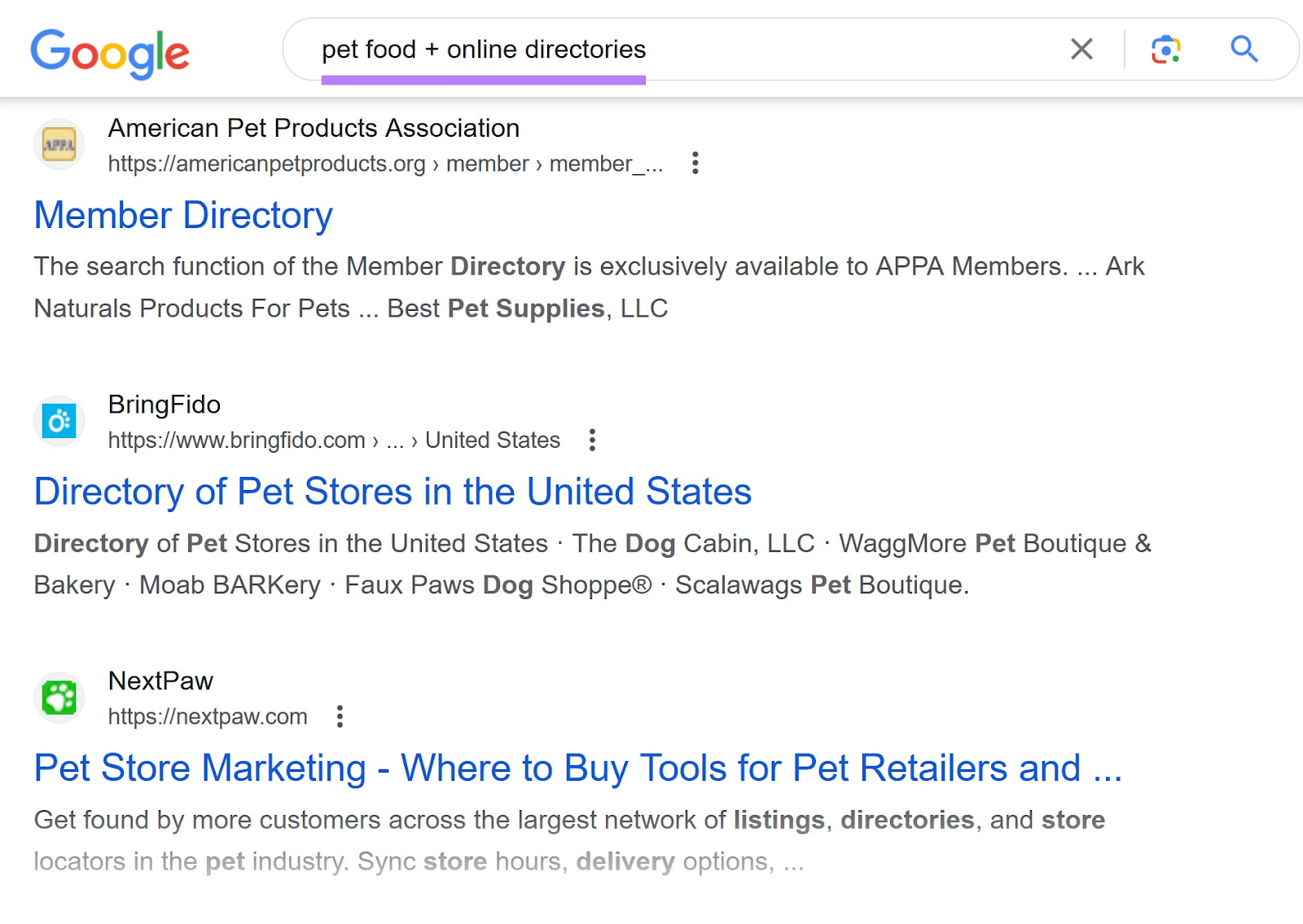
Add each applicable site to your outreach spreadsheet. Then, go through each result and send an email asking them to add your site to their lists.
5. Create Eye-Catching Infographics
Create infographics and other visual content marketing assets to sites that curate content in your niche.
Why?
Because visual content is easy to share and easy to read. And it gives you more opportunities to secure backlinks.
Let’s say you make sustainable sneakers. You could create an infographic that shows your manufacturing process.
Then, maybe a site that shares tips on how to be more eco-friendly comes across it. They decide to share it on their site.
As well as increasing your brand’s visibility, you get a high-quality backlink from a trusted site.
For instance, social media agency Giraffe created an infographic on “five lead generation ideas.” It was reposted by curation site Social Media Today:
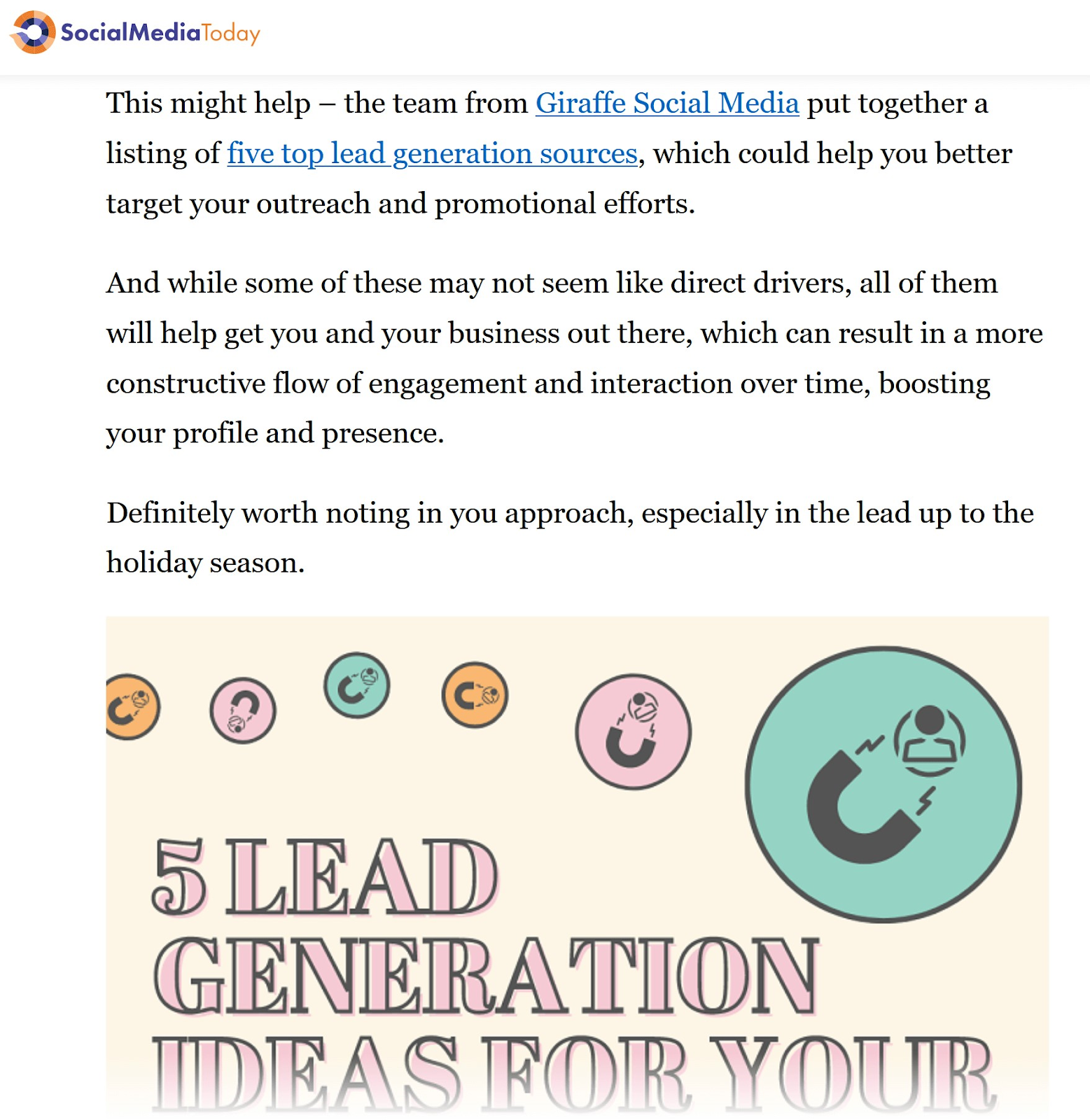
This displayed their services to a whole new relevant audience.
Plus, it gained them a link from a site with a strong Authority Score (AS) of 54.
Tools like Canva and Visme are great free options for quickly creating shareable infographics.
But if your art skills could use some work, you can always outsource to freelance designers. This strategy is only successful if your infographic is link-worthy content.
6. Snag Competitor Links
Finding broken, lost, and working competitor links is a way to use the competition’s backlinking efforts to improve your own:
- Broken link building involves finding external links on other sites that aren’t working
- Lost link building involves finding recently removed links to competitor sites
- Working competitor links lets you see what domains are linking to rival brands
In each of these cases, you can boost your backlinks by reaching out (via email) to the linking site and recommending your own webpage as a replacement or an additional resource to link to.
Let’s say you have a true ***** podcast similar to My Favorite Murder, which also has an ecommerce operation selling show-related merchandise.
Using Semrush’s Backlink Analytics, you can see the site has lost a link from Shopify:
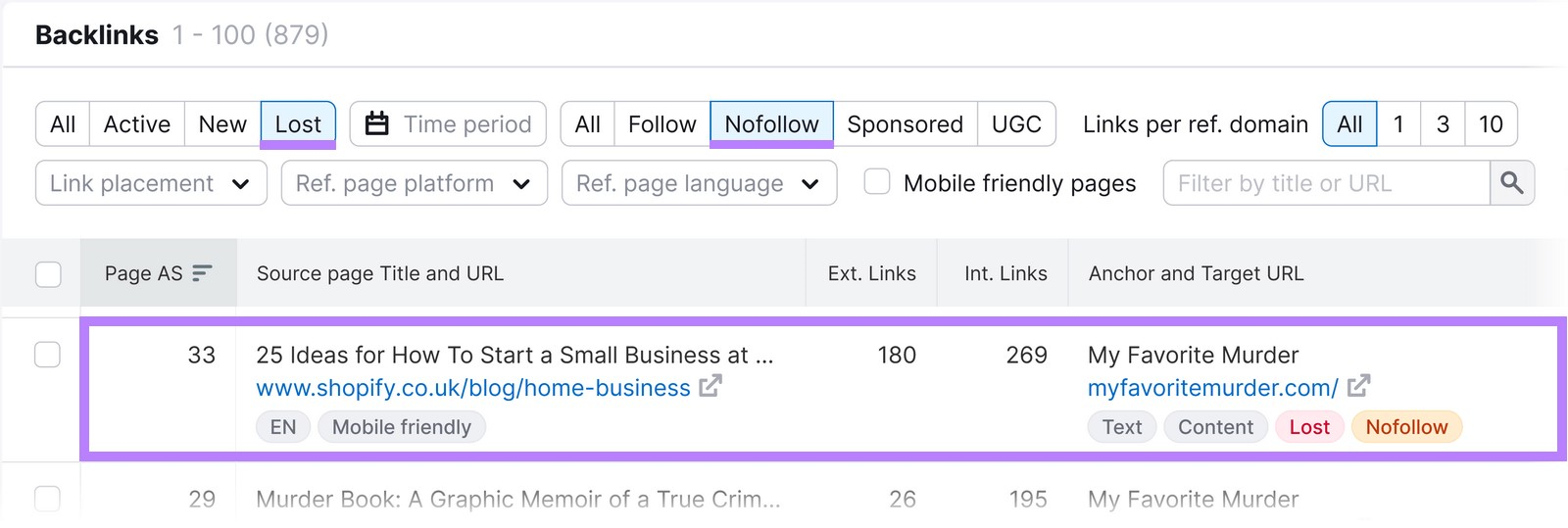
In the article, Shopify mentions the podcast hosts use Facebook groups, a paid community, and branched merch to build awareness.
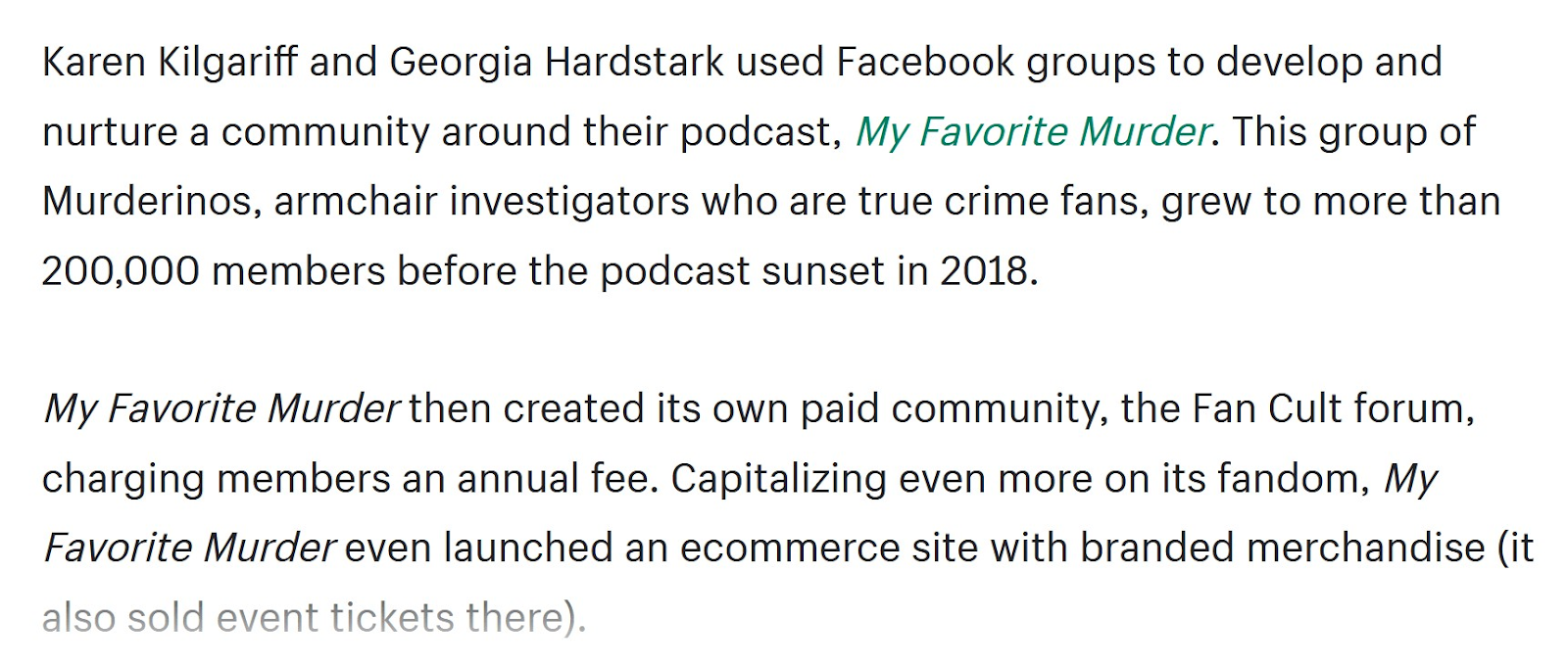
Because your podcast is in the same mold, it would be a perfect replacement case study. You could send an email suggesting yours as a direct swap.
This technique is one of the easiest ways to add to your backlink profile if you’re successful.
There are three ways to find broken, lost, and working competitor links using Semrush:
Broken Links
Head to the Backlink Analytics tool. Then, enter your domain and click “Analyze.”

Click “…” on the far right. Then “Competitors.”
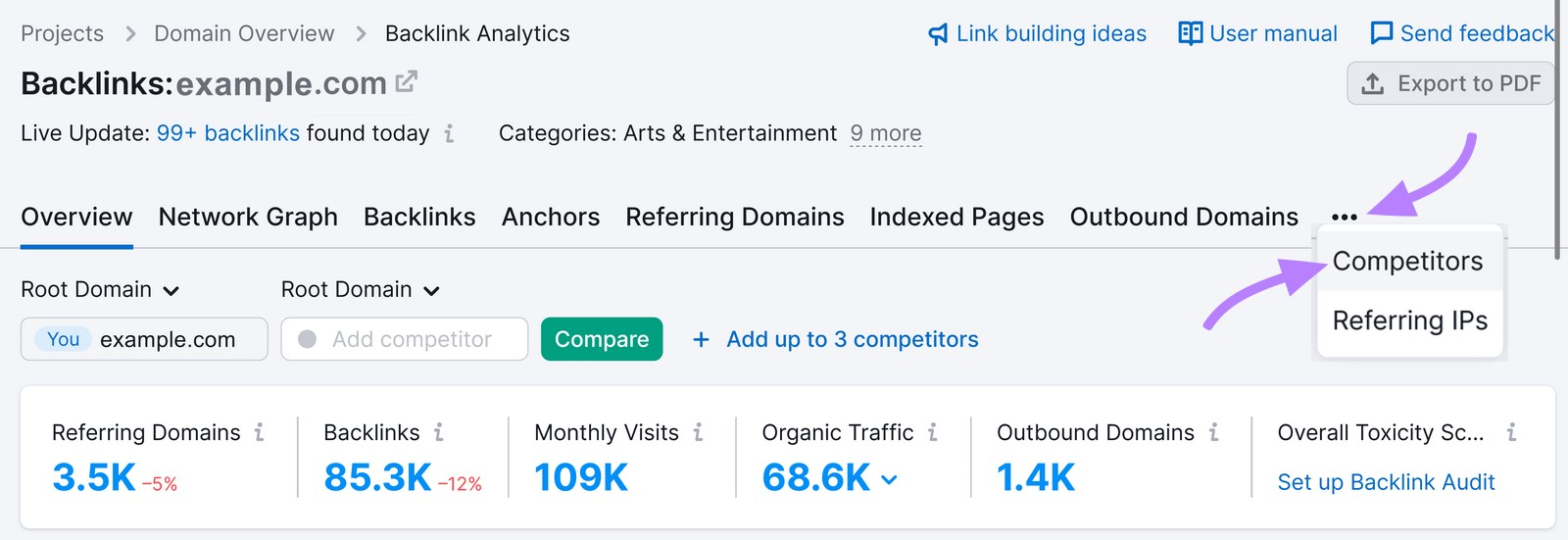
You’ll see a list of “Domain Competitors.”
This shows a list of competitors and links to their referring domains. Plus, those you have in common.
Click on the top competitor to view their backlinks.
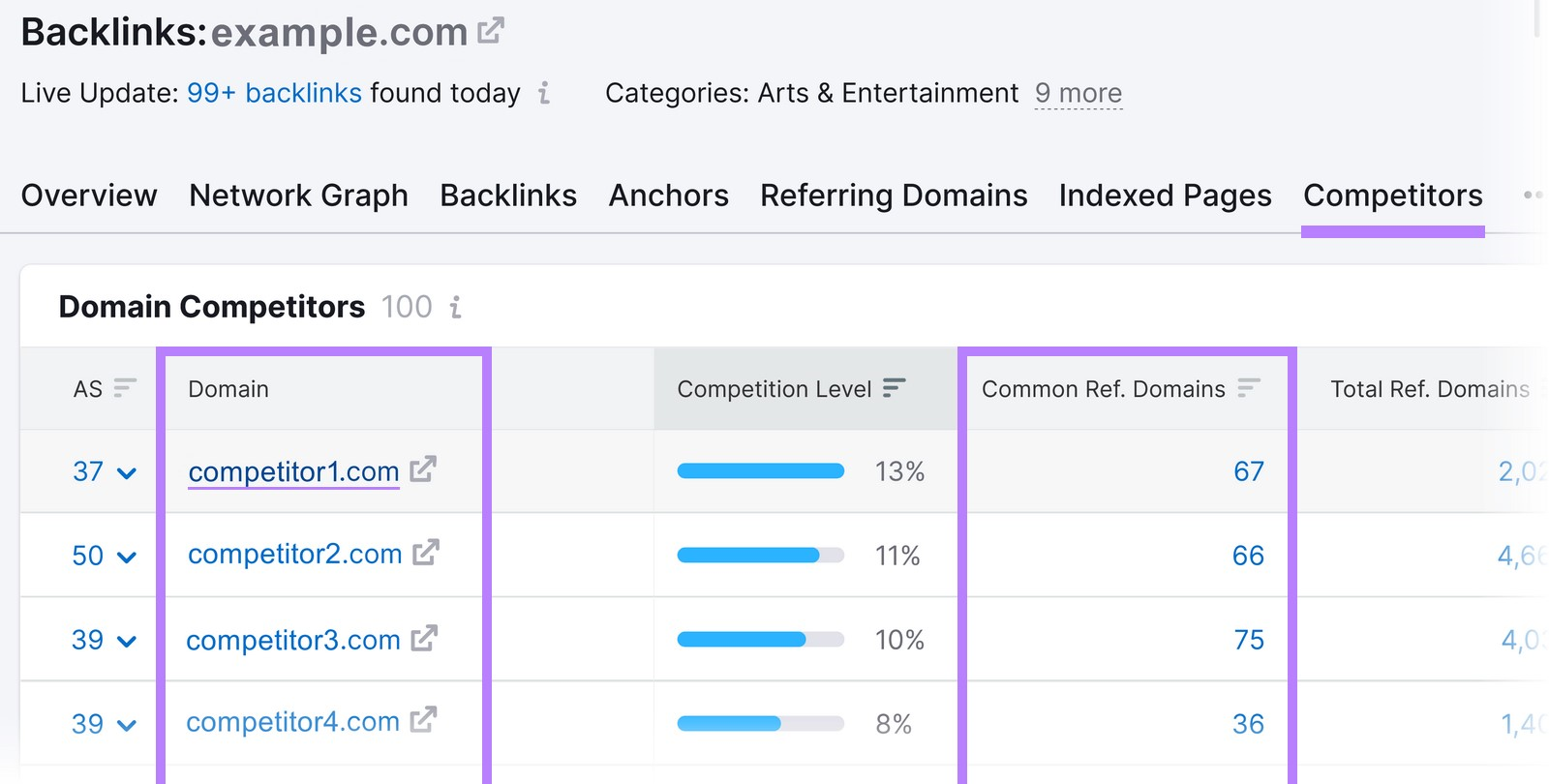
Head to the “Indexed Pages” tab.
Then check the box to apply the “Broken Pages” filter.
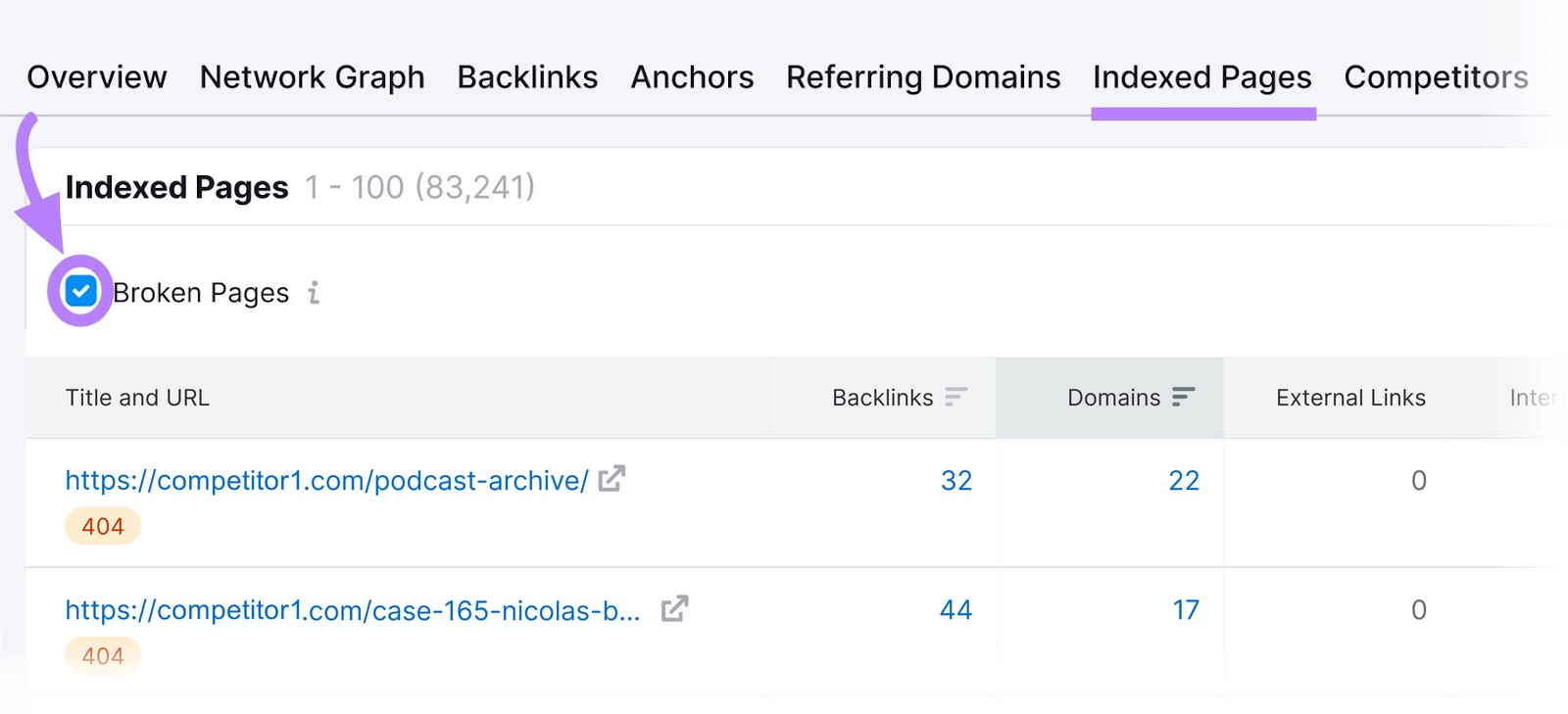
You’ll see a list of 4xx (Client Error) and 5xx (Server Error) codes.
Under the “Backlinks” column, click the number to see a breakdown of backlinks.
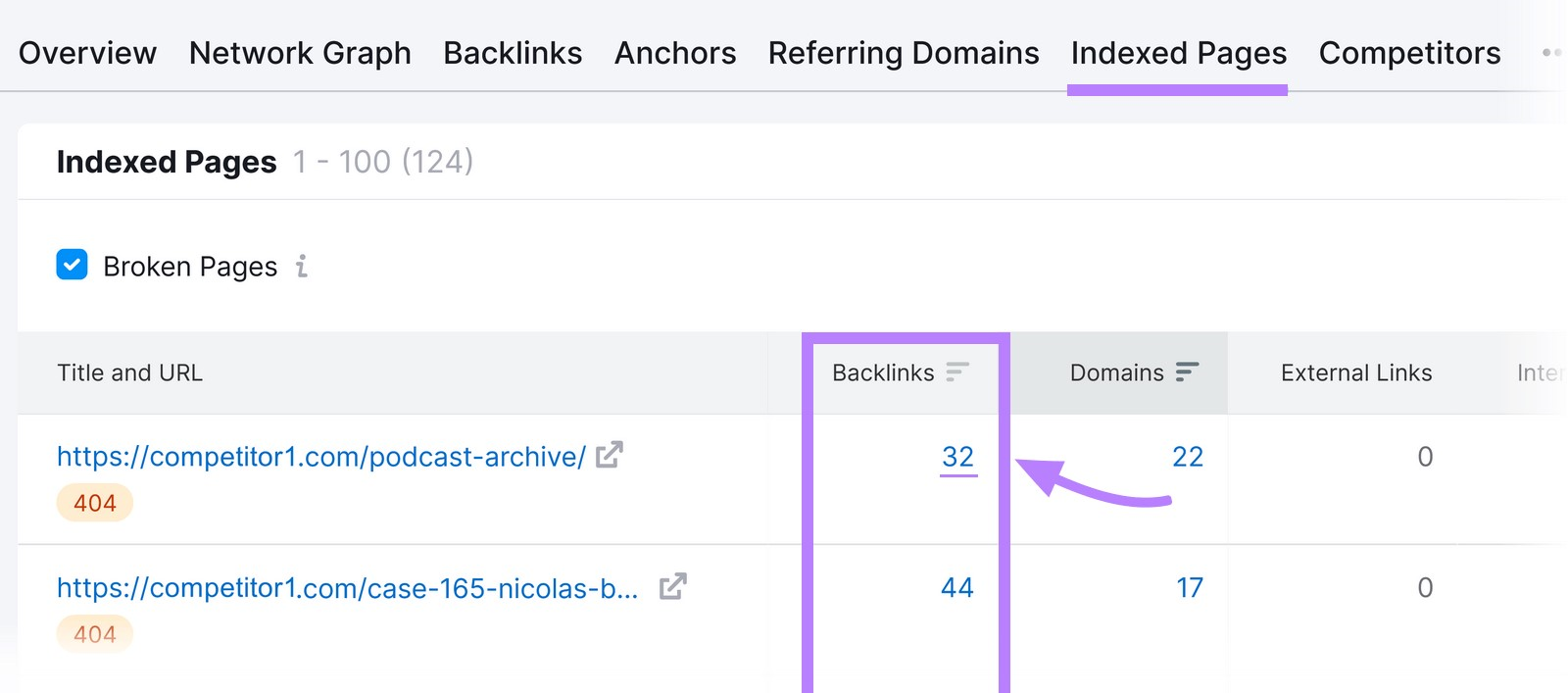
Click the “Active” tab to filter these backlinks. Then, hit “Export” to download the results.
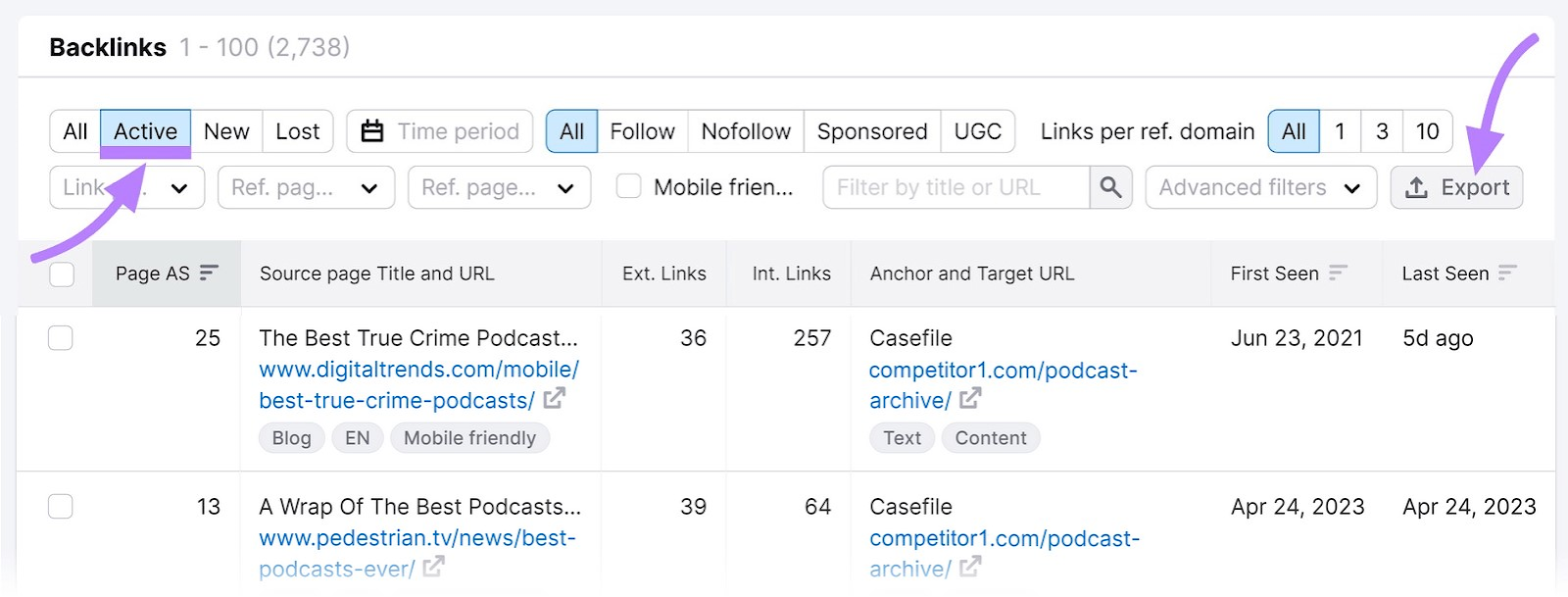
Repeat for your other competitors. Then combine all of your data in one spreadsheet.
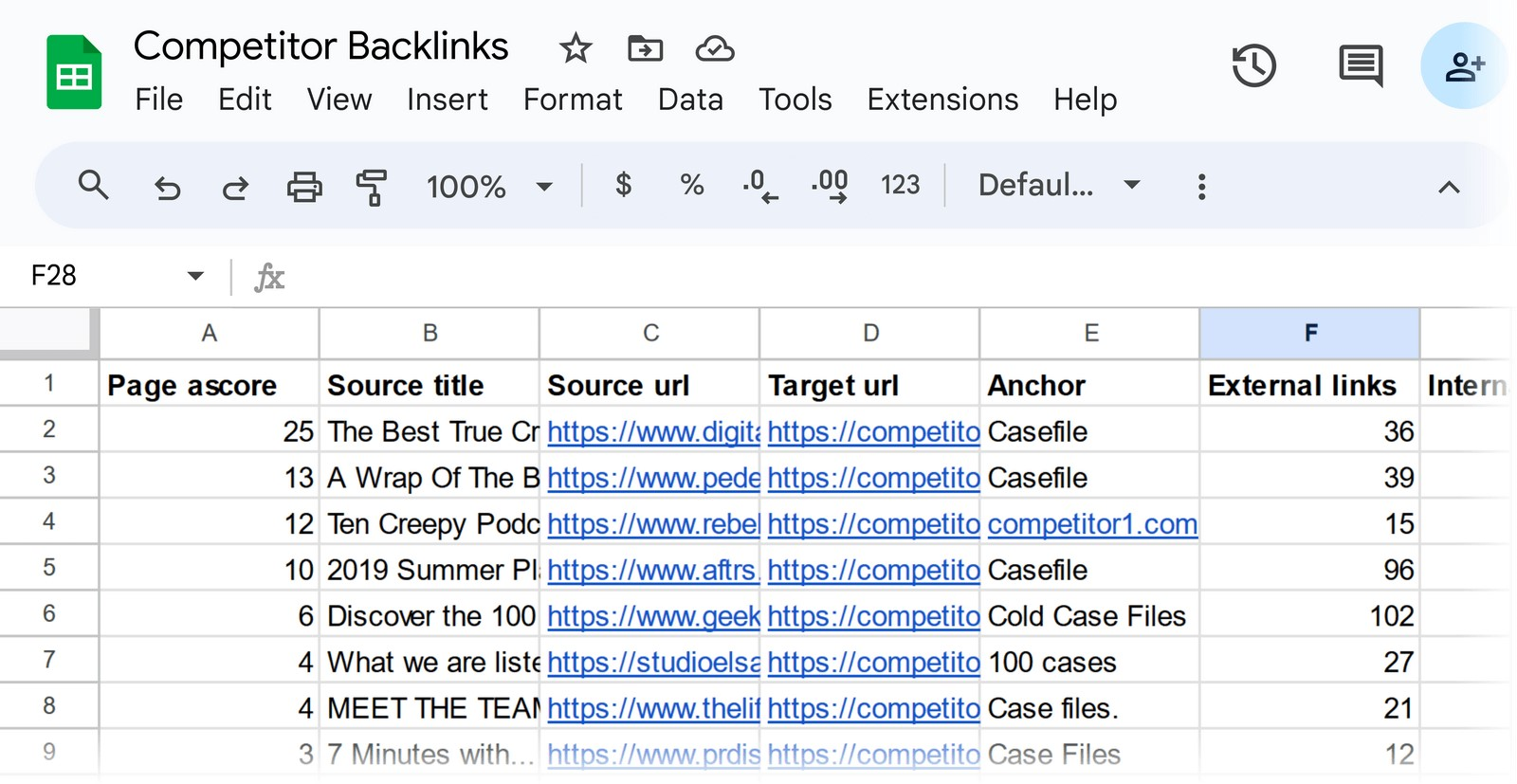
Use this spreadsheet to plan and track your outreach efforts. Or upload the file to the Link Building Tool and start your backlink campaign there.
Lost Links
To find lost links, head back to the main dashboard of the Backlink Analytics tool and select “Backlinks”:
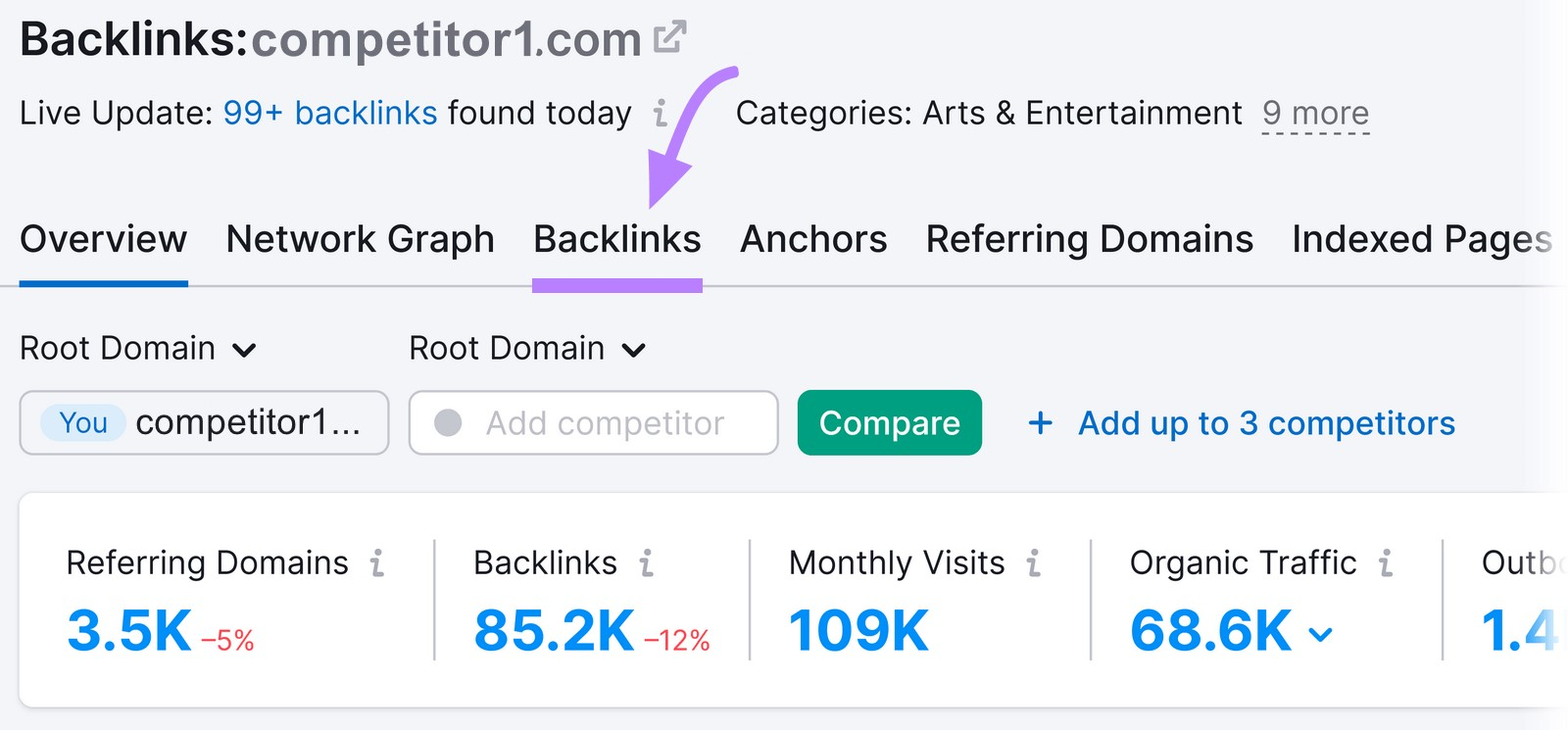
Scroll down and click the “Lost” tab.
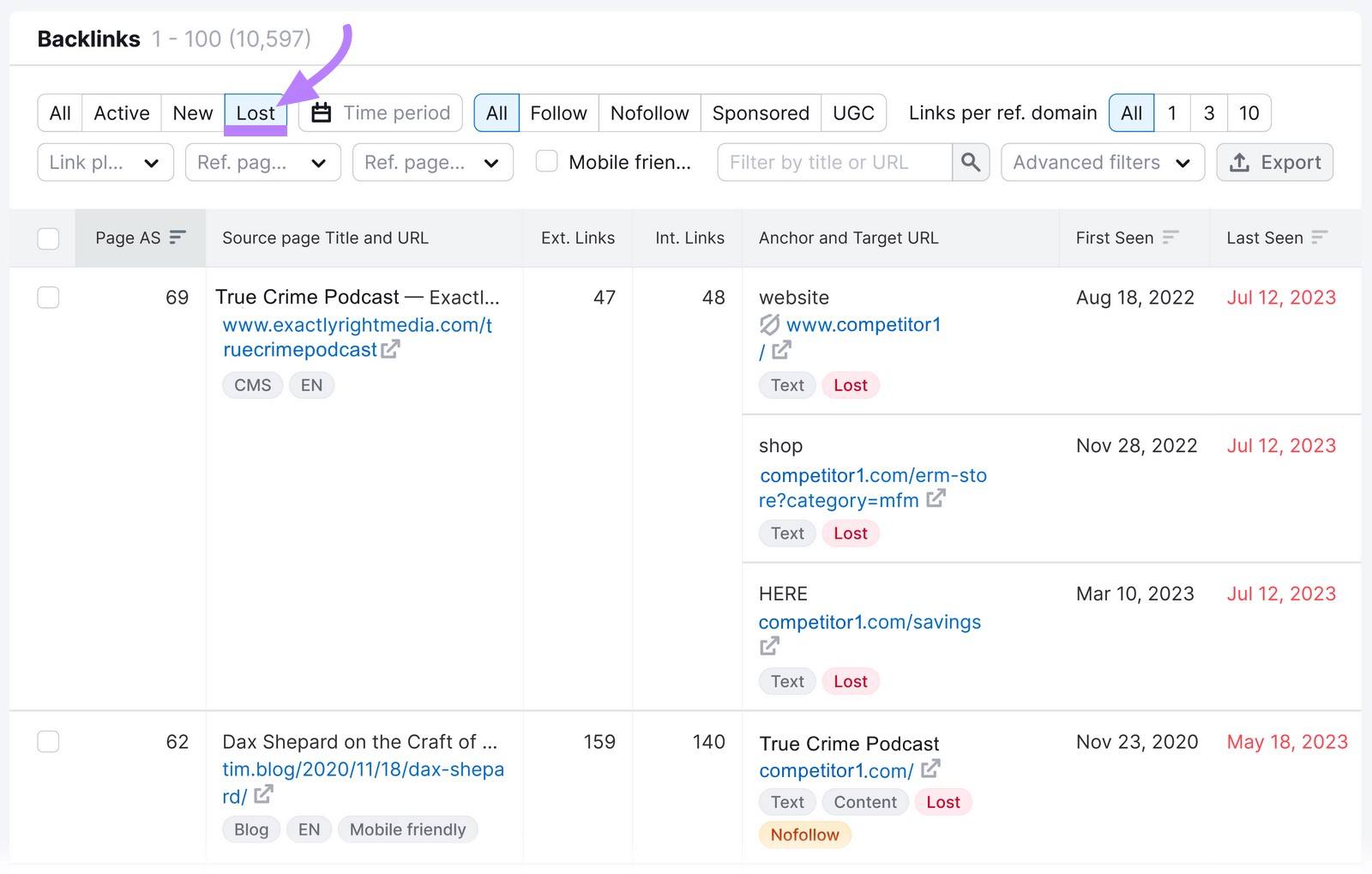
Export this list and add it to your spreadsheet. Repeat with other competitor domains.
Working Competitor Links
To find working links that point to your competitors, use Semrush’s Backlink Gap tool.
Head to the tool and enter your site’s domain.
When you click the second text box, the tool will auto-suggest four competitors.
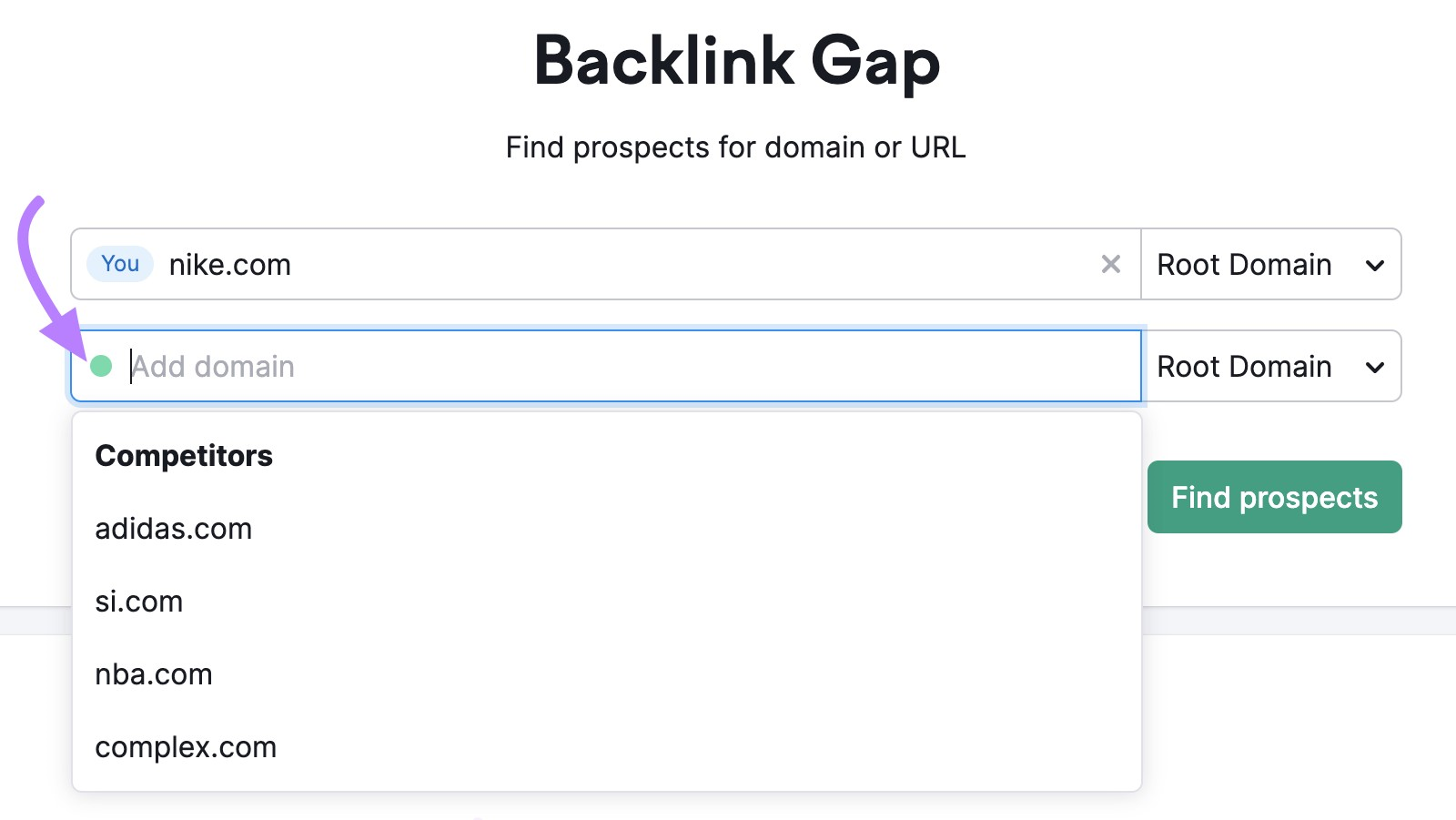
Choose one (or enter one of your own) and click “Find prospects.”
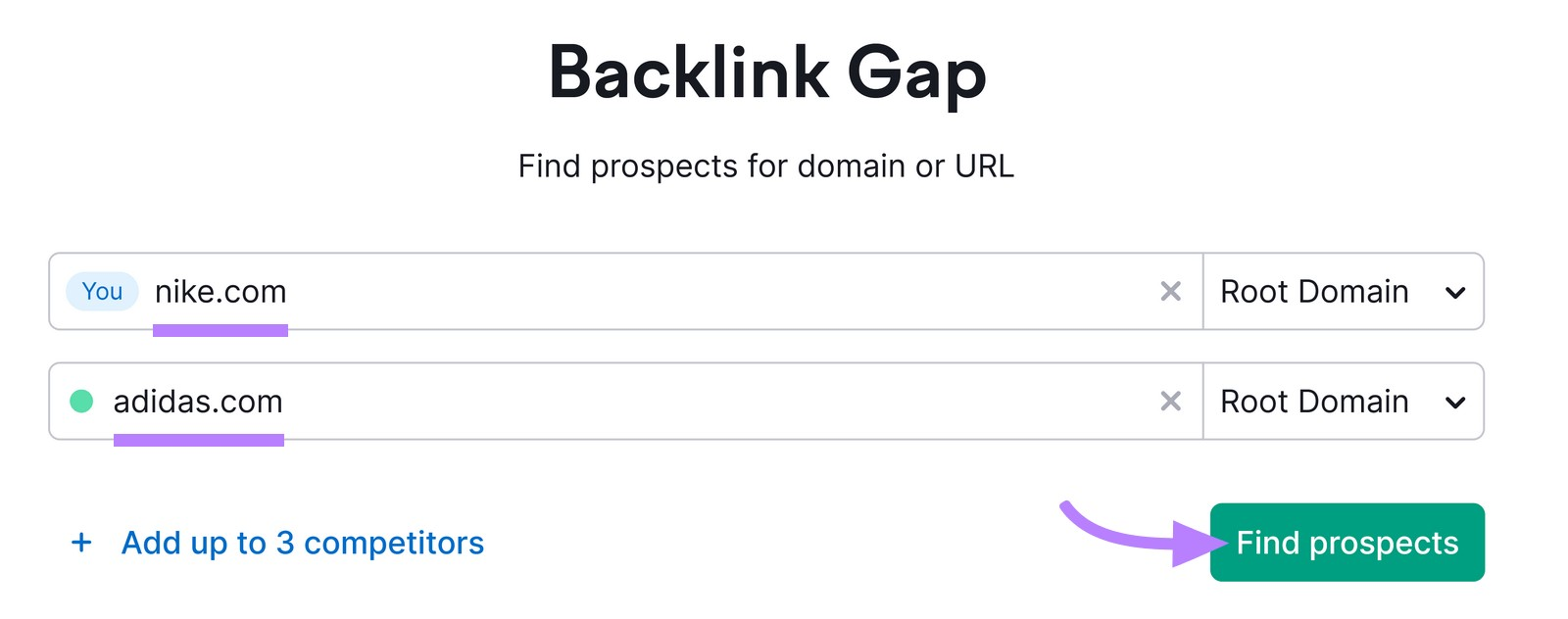
On the next dashboard, make sure your domain is selected.
Then click the “Best” tab.
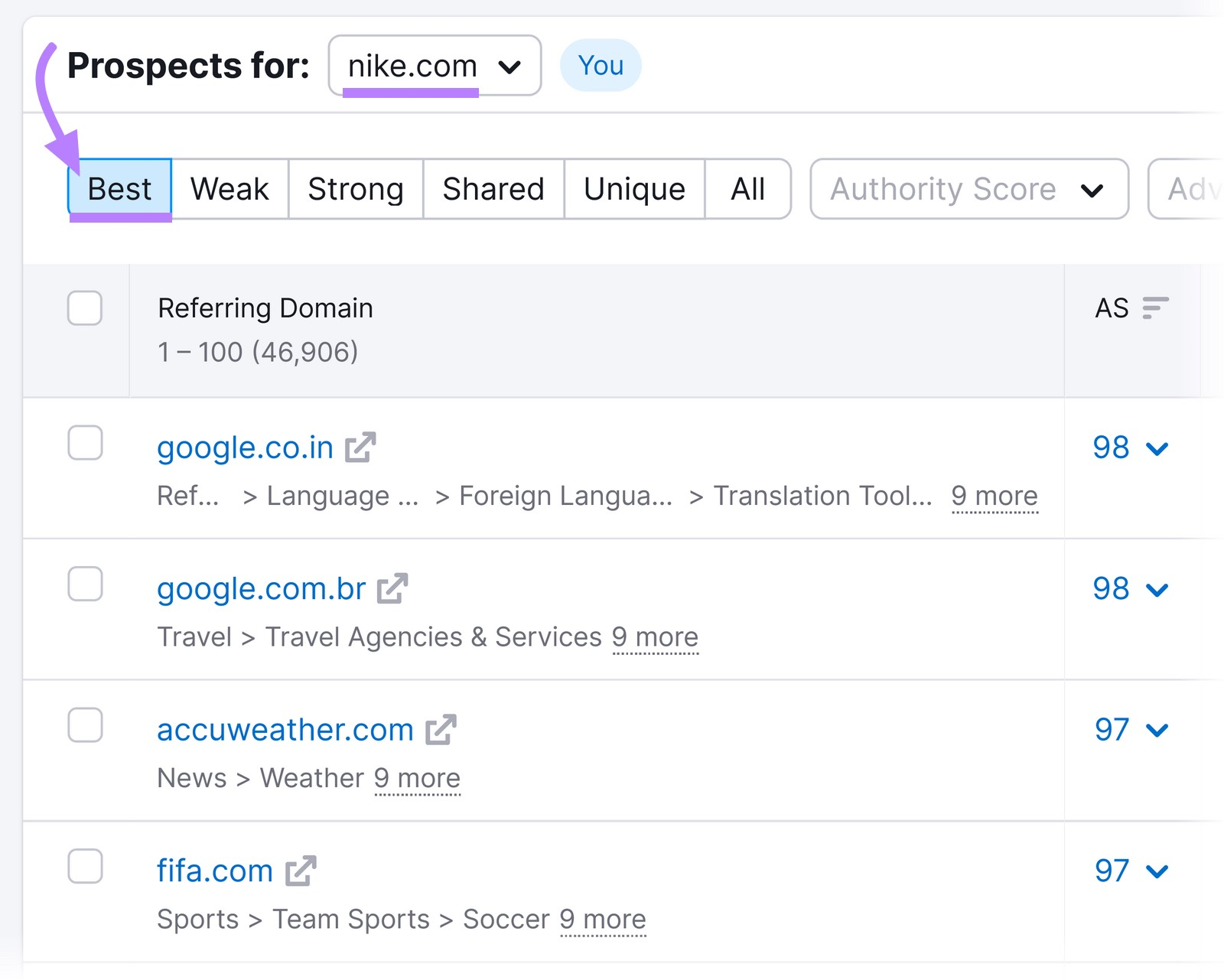
These are domains that point to all of your competitors but not you.
Add these to your spreadsheet. Then, move on to “Weak” (domains that point to you less than your competitors) and do the same.
Once you have a full spreadsheet of relevant backlinks to pursue, contact the website owners.
Where there are broken or lost links, ask to replace them with yours. Where there are mentions of your competitors but not you, ask to add yours to the list.
Spot your brand name and no backlink?
Kindly request that the site owner adds links to your ecommerce website where they mention your brand.
We’ll explain how to supplement your link building efforts with outreach in the next section.
7. Find and Reach Out to Resource Pages in Your Industry
Resource (or roundup) pages have the sole purpose of linking out to many pages in the same niche. So, you’ve got a good chance when you reach out to relevant pages and ask to be added too.
For example, here are a few resource pages for online plant delivery services:
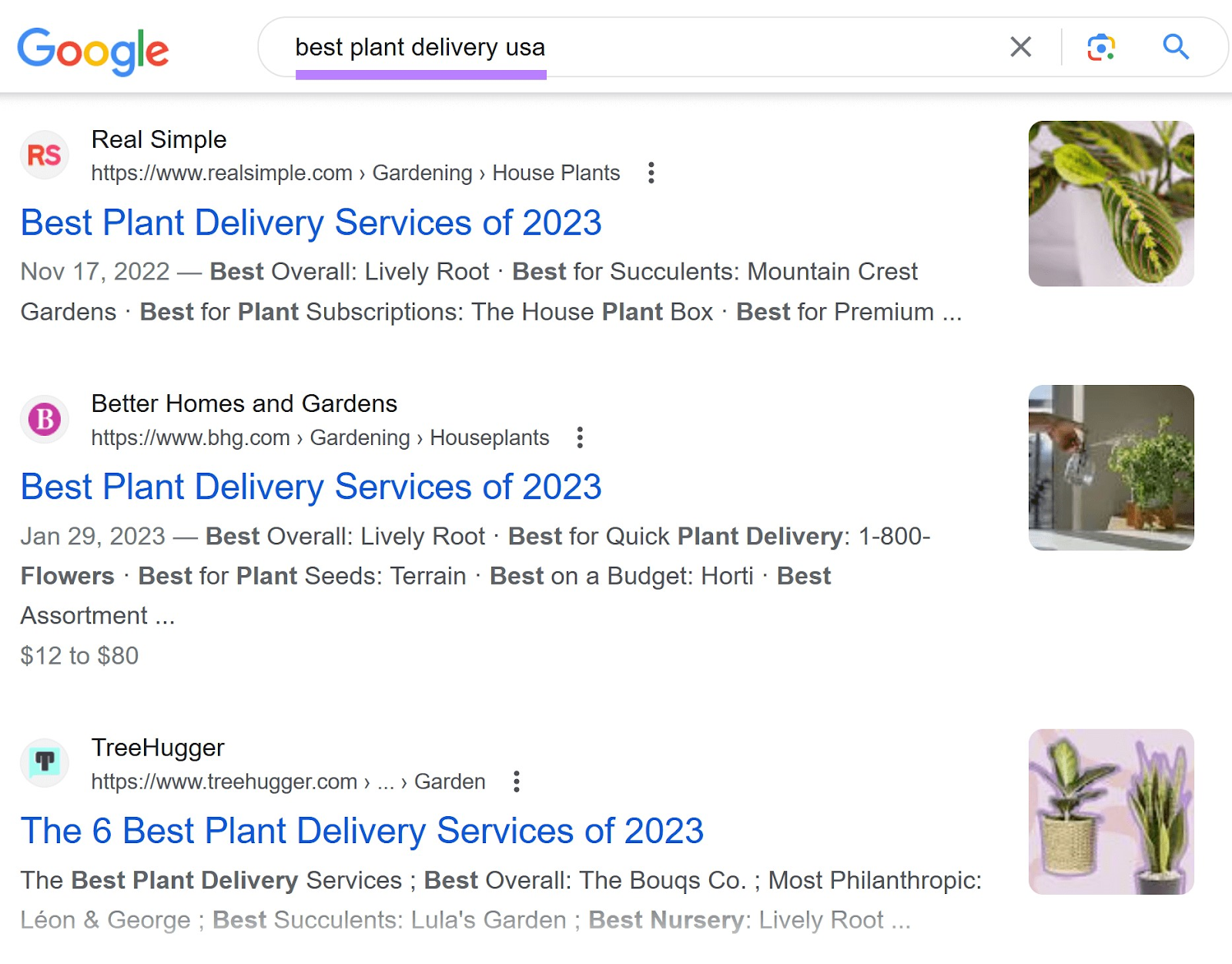
You can find relevant resource pages using Google.
For ecommerce sites, these will usually be “best product” type articles. But they don’t all share the same title format. So, try search terms like:
- “useful links” AND [product or service]
- “[product or service] useful resources”
- “[product or service] resources”
- “[topic] roundup”
- “[topic] resources”
- “best [product]”
- “ultimate list [topic]”
Once you have a list of pages, find contact details for each and add them to your spreadsheet. You can usually find out where to get in touch on a website’s contact or “about” pages.
You can also use an email finder tool like Hunter.io. Enter the domain name you want to find contact details for. The tool will come up with the most likely candidates:
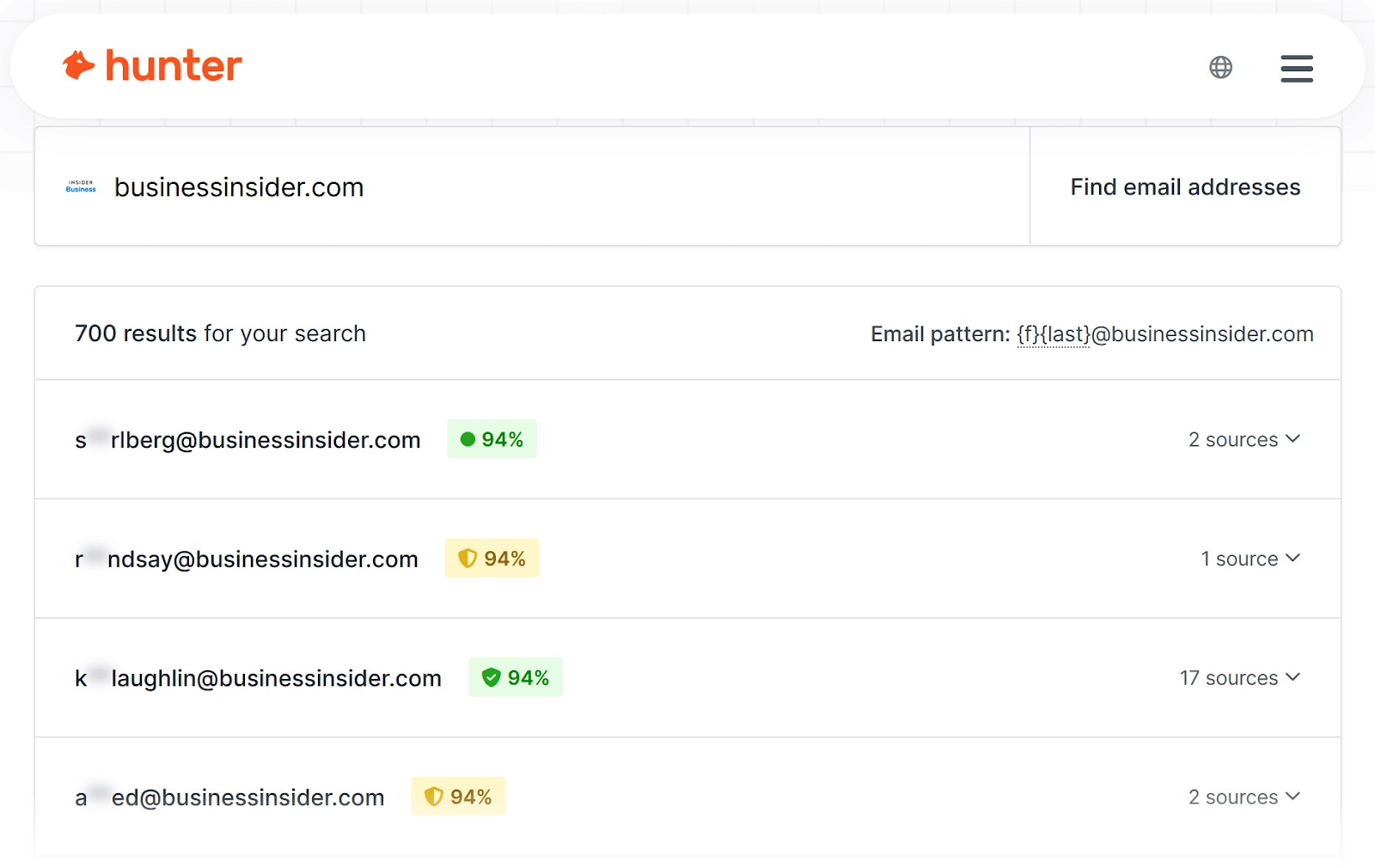
Hunter.io can speed up an already effective link building outreach process. And validate addresses you may have found on third-party sites.
Once you have the right contact details, reach out.
Remember that editors and website owners receive hundreds of link requests. To stand out, your emails should be eye-catching, descriptive, and personalized.
Start emails with a catchy subject line. Something as simple as adding numbers into your subject lines can take open rates from 12% to 20%.
In the main body of your email, get to the point quickly.
Once you’ve sent your email, wait a few days before following up. If there’s nothing after a few more days, try once more.
Further reading: For a full walkthrough on email outreach, check out our email outreach guide.
Ready to Start Your New Link Building Campaign?
These ecommerce link building strategies will help you increase search visibility and attract more traffic to your store.
But first, you need to set a benchmark to track success.
Use Semrush’s Backlink Analytics tool to find the number and type of backlinks you already have pointing to your site. This will provide the foundation to grow and improve your backlink profile.
Source link : Semrush.com
